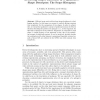630 search results - page 70 / 126 » Combining Two Formalism for Reasoning about Concepts |
ATAL
2006
Springer
14 years 17 days ago
2006
Springer
Qualitative Coalitional Games (QCGs) are a version of coalitional games in which an agent's desires are represented as goals which are either satisfied or unsatisfied, and ea...
EMSOFT
2008
Springer
13 years 10 months ago
2008
Springer
We focus on decomposition of hard-masking real-time faulttolerant programs (where safety, timing constraints, and liveness are preserved in the presence of faults) that are design...
CIVR
2006
Springer
14 years 16 days ago
2006
Springer
Abstract. Efficient image retrieval from large image databases is a challenging problem. In this paper we present a method offering constant time complexity for the comparison of t...
POPL
2007
ACM
14 years 9 months ago
2007
ACM
We present a formal model of memory that both captures the lowlevel features of C's pointers and memory, and that forms the basis for an expressive implementation of separati...
NMR
2004
Springer
14 years 2 months ago
2004
Springer
Within the law, the traditional test for attributing causal responsibility is the counterfactual “but-for” test, which asks whether the injury complained of would have occurre...

